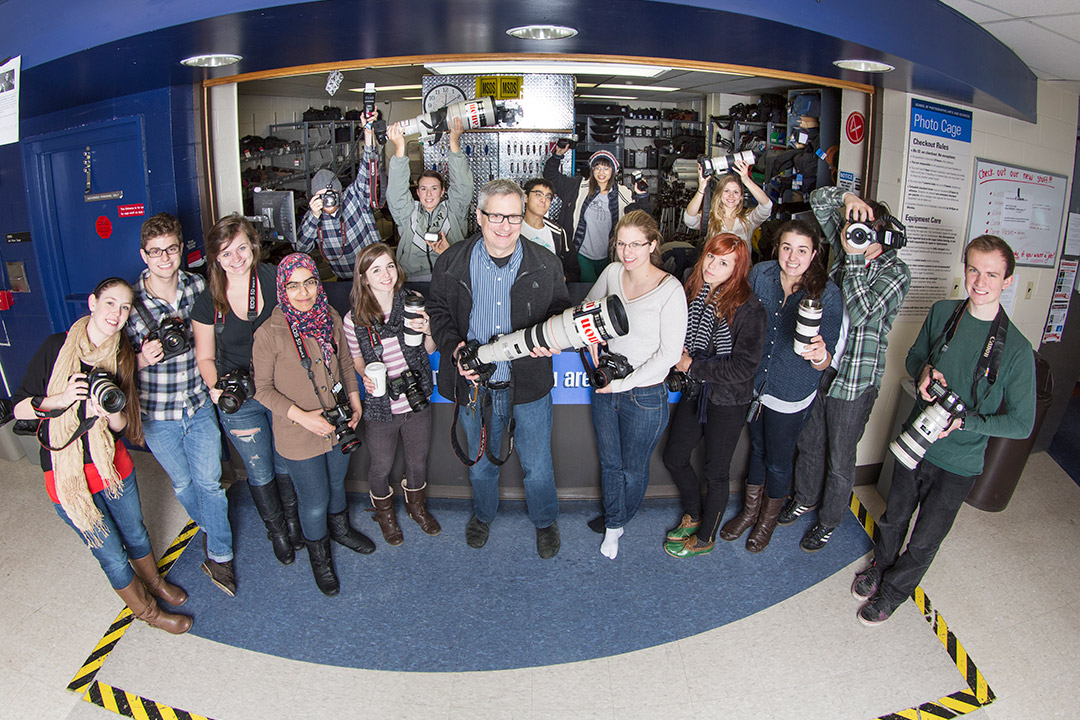Frank Cost, former dean, teacher, and industry consultant, retires after four decades
College of Art and Design professor also co-founded Printing Industry Center at RIT
Dan Wang
Frank Cost, center, is surrounded by a number of photo students during a Canon event. He is retiring after a 40-year career at RIT.
Frank Cost, who served as associate dean and then interim dean of what was then RIT’s College of Imaging Arts and Sciences (now the College of Art and Design) from 1997 through 2011, is retiring after 40 years.
Most recently the James E. McGhee Professor in the School of Photographic Arts and Sciences, Cost also was founding co-director of the Printing Industry Center at RIT, an Alfred P. Sloan Foundation Industry Studies Center, in 2001, along with Patricia Sorce. He is the author of numerous books—including The New Medium of Print: Material Communications in the Internet Age—and articles exploring the impact of digital technology and digital culture on traditional forms of creative expression. Cost’s work developing innovative uses for digitally produced photo books attracted funding for a number of research-and-development projects involving both undergraduate and graduate students at RIT.
Cost collaborated closely with numerous academic programs during his four decades at RIT, including art, crafts, design, printing, publishing, photography, film and animation, and new media. A regular advisor to the graphic communications industry on strategies for new technology acquisition and process integration, he steered technology manufacturers seeking to understand industry needs. In addition to RIT, Cost taught throughout the United States as well as Europe, Asia, South America, and the Middle East.
What are you most proud of when looking back at your 40 years at RIT?
I can’t say that I feel pride, but rather gratitude for the opportunities I have had as a result of the generations of hard work that preceded my time at RIT to establish the worldwide reputation of the university in the disciplines of graphic arts and photography. I am grateful for the generosity of certain people who took me under their wings as mentors during my early years. These include Robert Chung, Mark Guldin, Miles Southworth, Robert Hacker, Richard Rose, Bill Destler, Joan Stone, and many others. I am also grateful for the students who sat in my classes and labs over the years and gave purpose to my life, and for the families who supported their study. Without these people, along with more than my fair share of good luck, I could have been twice as intelligent, and worked 10 times as hard, and never had the successes I’ve enjoyed. Whenever I think of significant achievements such as the creation of new academic or research programs, there were always several other key people involved, without whom nothing of substance would have been possible.
What were some of the most effective ways you connected with your students?
Now that I’m about to retire, I can admit this: I always disliked being in school from almost the first day of kindergarten. I disliked being coerced into tearing myself away from what I was interested in thinking about to attend to what someone else required me to think about. So, as a teacher, I have always assumed my students are suffering the same agonies, and I’ve tried to encourage them to find ways to connect their interests with the requirements of the coursework at hand. This is easier to accomplish in the creative disciplines than in more objective knowledge-based fields, so the world of art and design became my academic salvation.
What are your post-RIT plans?
I plan to continue to record the sights and sounds of the world around me and to use all the magnificent tools of our trade to share my experiences with others through various media channels. I’ll volunteer to help other individuals and organizations in Rochester do the same. I’ll practice music diligently every day and look for opportunities to play with other musicians. I’ll strive to give the people in my life as much of my undivided attention as they wish. I’ll stay close to home and try to arrive early for all my medical appointments.













